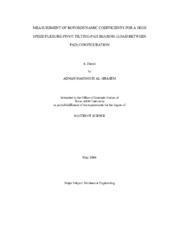| dc.contributor.advisor | Childs, Dara W. | |
| dc.creator | Al-Ghasem, Adnan Mahmoud | |
| dc.date.accessioned | 2005-08-29T14:41:10Z | |
| dc.date.available | 2005-08-29T14:41:10Z | |
| dc.date.created | 2006-05 | |
| dc.date.issued | 2005-08-29 | |
| dc.identifier.uri | https://hdl.handle.net/1969.1/2415 | |
| dc.description.abstract | This thesis presents the dynamic and static forced performance of a flexure-pivot tilting-pad bearing load between pad (LBP) configuration for different rotor speeds and bearing unit loadings. The bearing has the following design parameters: 4 pads with pad arc angle 72o and 50% pivot offset, pad axial length 0.0762 m (3 in), pad radial clearance 0.254 mm (0.010 in), bearing radial clearance 0.1905 mm (0.0075 in), preload 0.25 and shaft nominal diameter of 0.11684 m (4.600 in). The dynamic coefficients and the static performance parameters of the FPB have been compared with the theoretical predictions using the isothermal analysis from the rotordynamic software suite XLTRC2-XLTFPBrg.
The bearing shows a small attitude angle, about 10o, which indicates small crosscoupling stiffnesses. The pad temperatures increase in the circumferential direction of rotation with speed and load. The pads maximum temperature was measured near the trailing edge.
The dependency of the stiffness and damping coefficients on the excitation frequency has been studied. The frequency dependency in the dynamic coefficients was removed by introducing an added mass coefficient to the bearing model. The direct added mass coefficients were around 32 kg. The direct stiffness and damping coefficients increase with load, while increasing and decreasing with rotor speed, respectively. A small whirl frequency ratio (WFR) was found of about 0.15, and it decreases with load and increases with speed.
A comparison between the dynamic stiffnesses using a Reynolds equation and the bulk-flow Navier-Stokes models with the experimental dynamic stiffnesses shows that the Reynolds model (even for laminar flows) is not adequate, and that the bulk-flow model should be used for rotordynamic coefficients prediction. The bulk-flow model in general predicts well the static performance parameters and the direct dynamic coefficients, and underpredicts the cross-coupled coefficients (overpredicts the stability). | en |
| dc.format.extent | 1650261 bytes | en |
| dc.format.medium | electronic | en |
| dc.format.mimetype | application/pdf | |
| dc.language.iso | en_US | |
| dc.publisher | Texas A&M University | |
| dc.subject | Flexure-pivot,Tilting Pad Bearing,Dynamic Coefficients,Pad Temperature,frequency dependency | en |
| dc.title | Measurement of rotordynamic coefficients for a high-speed flexure pivot tilting-pad bearing(load between pad) configuration | en |
| dc.type | Book | en |
| dc.type | Thesis | en |
| thesis.degree.department | Mechanical Engineering | en |
| thesis.degree.discipline | Mechanical Engineering | en |
| thesis.degree.grantor | Texas A&M University | en |
| thesis.degree.name | Master of Science | en |
| thesis.degree.level | Masters | en |
| dc.contributor.committeeMember | Toliyat, Hamid A. | |
| dc.contributor.committeeMember | San Andres, Luis | |
| dc.type.genre | Electronic Thesis | en |
| dc.type.material | text | en |
| dc.format.digitalOrigin | born digital | en |


